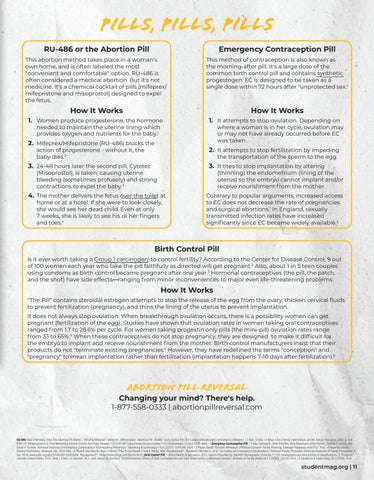Pills, pills, Pills RU-486 or the Abortion Pill
Emergency Contraception Pill
This abortion method takes place in a woman's own home, and is often labeled the most "convenient and comfortable" option. RU-486 is often considered a medical abortion. But it's not medicine. It's a chemical cocktail of pills (mifeprex/ mifepristone and misoprostol) designed to expel the fetus.
This method of contraception is also known as the morning-after pill. It's a large dose of the common birth control pill and contains synthetic progestogen. EC is designed to be taken as a single dose within 72 hours after "unprotected sex."
How It Works
How It Works
1. Women produce progesterone, the hormone needed to maintain the uterine lining which provides oxygen and nutrients for the baby.1
2. Mifeprex/Mifepristone (RU-486) blocks the
1. It attempts to stop ovulation. Depending on
where a woman is in her cycle, ovulation may or may not have already occurred before EC was taken.
2. It attempts to stop fertilization by impeding
action of progesterone - without it, the baby dies.2
the transportation of the sperm to the egg.
3. 24-48 hours later the second pill, Cytotec
3. It tries to stop implantation by altering
(Misoprostol), is taken, causing uterine bleeding (sometimes profusely) and strong contractions to expel the baby.3
(thinning) the endometrium (lining of the uterus) so the embryo cannot implant and/or receive nourishment from the mother.
4. The mother delivers the fetus over the toilet at home or at a hotel. If she were to look closely, she would see her dead child. Even at only 7 weeks, she is likely to see his or her fingers and toes.4
Contrary to popular arguments, increased access to EC does not decrease the rate of pregnancies and surgical abortions.1 In England, sexually transmitted infection rates have increased significantly since EC became widely available.2
Birth Control Pill Is it ever worth taking a Group 1 carcinogen to control fertility? According to the Center for Disease Control, 9 out of 100 women each year who take the pill faithfully as directed will get pregnant.2 Also, about 1 in 5 teen couples using condoms as birth control became pregnant after one year.3 Hormonal contraceptives (the pill, the patch, and the shot) have side effects—ranging from minor inconveniences to major even life-threatening problems. 1
How It Works "The Pill" contains steroidal estrogen attempts to stop the release of the egg from the ovary, thicken cervical fluids to prevent fertilization (pregnancy), and thins the lining of the uterus to prevent implantation. It does not always stop ovulation. When breakthrough ovulation occurs, there is a possibility women can get pregnant (fertilization of the egg). Studies have shown that ovulation rates in women taking oral contraceptives ranged from 1.7 to 28.6% per cycle. For women taking progestin only pills (the mini-pill) ovulation rates range from 33 to 65%.4 When these contraceptives do not stop pregnancy, they are designed to make it difficult for the embryo to implant and receive nourishment from the mother. Birth control manufacturers insist that their products do not "terminate existing pregnancies." However, they have redefined the terms "conception" and "pregnancy" to mean implantation rather than fertilization (implantation happens 7-10 days after fertilization).5
Abortion pill reversal
Changing your mind? There's help. 1-877-558-0333 | abortionpillreversal.com
RU-486: Bad Chemicals: How The Abortion Pill Works 1 “What Is Mifeprex?” Mifeprex - Mifepristone - Abortion Pill - RU486 - Early Option Pill, 2019, www.earlyoptionpill.com/what-is-mifeprex/. | 2 Ibid. | 3 Ibid. | 4 Mayo Clinic Family Health Book. 3rd ed. Harper Resource, 2003. p. 268 Print. | 5 “Mifepristone U.S. Post-Marketing Adverse Events Summary through 12/31/20188” https://www.fda.gov/media/112118/download, 12 April 2109. Web.~ | Emergency Contraceptive Pill: 1 Polis, Chelsea B., Kate Schaffer, Kelly Blanchard, Anna Glasier, Cynthia C. Harper, and David A. Grimes. “Advance Provision of Emergency Contraception for Pregnancy Prevention.” Obstetrics & Gynecology 110.6 (2007): 1379-388. Print. | 2 Paton, David. “Random Behaviour or Rational Choice? Family Planning, Teenage Pregnancy and STIs.” Proc. of Royal Economic Society Conference, Swansea. Apr. 2004.Web. | 3 “Plan B One-Step® | How It Works.” Plan B One-Step® | How It Works. Web. Replacement? - Bosworth, Michele C., et al. “An Update on Emergency Contraception.” American Family Physician, American Academy of Family Physicians, 1 Apr. 2014, www.aafp.org/afp/2014/0401/p545.html. Replacement? - https://www.drugs.com/plan-b.html | Birth Control Pill: 1 World Health Organization, 2021, Agents Classified by the IARC Monographs, Volumes 1–129, monographs.iarc.who.int/list-of-classifications. 2 “Products.” Janssen United States. 2016. Web. | 3 Ibid. | 4 Larimore, W. L., and Joseph B. Stanford. “Postfertilization Effects of Oral Contraceptives and Their Relationship to Informed Consent.” Archives of Family Medicine 9.2 (2000): 126-33. Print. | 5 Obstetrics & Gynecology 26.3 (1965). Print.
studentmag.org | 11











